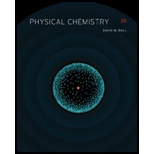
Physical Chemistry
2nd Edition
ISBN: 9781133958437
Author: Ball, David W. (david Warren), BAER, Tomas
Publisher: Wadsworth Cengage Learning,
expand_more
expand_more
format_list_bulleted
Question
Chapter 18, Problem 18.6E
Interpretation Introduction
Interpretation:
The nuclear contributions to
Concept introduction:
Different linearly independent wavefunctions that have same energy are called degenerate. This is expressed in terms of degeneracy. If two functions are having same energy then they are called doubly degenerate and so on. The nuclear partition function is represented as,
Where,
•
Expert Solution & Answer
Trending nowThis is a popular solution!

Students have asked these similar questions
Indicate the product that is obtained if the benzotriazol reacts with dimethyl sulfate.
Indicate how to obtain 2-metilbencimidazol from 1,2-diaminobenzene.
break down both reactions shown and explain it correctly using the bromonium ion mechanism, instead of the (disproven) carbocation-based mechanism.
Chapter 18 Solutions
Physical Chemistry
Ch. 18 - Prob. 18.1ECh. 18 - Prob. 18.2ECh. 18 - Prob. 18.3ECh. 18 - Prob. 18.4ECh. 18 - The following are the first four electronic energy...Ch. 18 - Prob. 18.6ECh. 18 - Prob. 18.7ECh. 18 - Prob. 18.8ECh. 18 - Prob. 18.9ECh. 18 - Prob. 18.10E
Ch. 18 - Prob. 18.11ECh. 18 - Prob. 18.12ECh. 18 - Prob. 18.13ECh. 18 - Prob. 18.14ECh. 18 - Prob. 18.15ECh. 18 - Prob. 18.16ECh. 18 - Prob. 18.17ECh. 18 - Prob. 18.18ECh. 18 - Prob. 18.19ECh. 18 - Prob. 18.20ECh. 18 - Prob. 18.21ECh. 18 - Prob. 18.22ECh. 18 - Prob. 18.23ECh. 18 - Prob. 18.24ECh. 18 - Prob. 18.25ECh. 18 - Prob. 18.26ECh. 18 - Prob. 18.27ECh. 18 - Prob. 18.28ECh. 18 - Prob. 18.29ECh. 18 - Prob. 18.30ECh. 18 - Prob. 18.31ECh. 18 - Prob. 18.32ECh. 18 - Prob. 18.33ECh. 18 - What are qnuc and qrot for N2(I=1)? See Table 18.3...Ch. 18 - The rovibrational spectrum of acetylene, HCCH,...Ch. 18 - Prob. 18.36ECh. 18 - Prob. 18.37ECh. 18 - Prob. 18.38ECh. 18 - Prob. 18.39ECh. 18 - Prob. 18.40ECh. 18 - Prob. 18.41ECh. 18 - Prob. 18.42ECh. 18 - Use equation 18.44 to show that pV=NkT.Ch. 18 - Prob. 18.44ECh. 18 - Determine E,H,G, and S for CH4 at standard...Ch. 18 - Prob. 18.48ECh. 18 - Prob. 18.49ECh. 18 - Calculate the heat capacity of NO2 at 298K and...Ch. 18 - Prob. 18.51ECh. 18 - In Chapters 17 and 18 we have derived expressions...Ch. 18 - Prob. 18.55ECh. 18 - Prob. 18.56ECh. 18 - Prob. 18.57ECh. 18 - Prob. 18.58ECh. 18 - Prob. 18.59ECh. 18 - Prob. 18.60E
Knowledge Booster
Similar questions
- Indicate how from 1,2-diaminobenzene to obtain 1-metilbenzotriazol.arrow_forward-C = C - C - + Br₂ + I" -> -C-C-c -C = C -C- + Br² + I₂ -C=C Br I + Brū + Iz -7- C - C-C- I Br Mechanism; - C = c - c - + Br - Br > - C-c-c- Br -C-C-C- + 1 - - -Ċ-Ċ'-c' - Br Br Iarrow_forwardWrite the mechanism of the esterification reaction (please show the mechanism included line pairs and arrows)arrow_forward
- How do I break down the reaction shown on the chalkboard and explain it correctly using the bromonium ion mechanism, instead of the (disproven) carbocation-based mechanismarrow_forward¿Qué the product is obtained from tetraethoxypropano and hidrazina?. Indicate the reason why the corresponding dial is used.arrow_forwardIf CH3COCH2CH(OCH3)2 is reacted with hydrazine, two isomeric products are formed. Indicate their structures and the major product.arrow_forward
- Is it possible to obtain addition derivatives to nitrogen in position 2 of pyrazoles by reaction with electrophilic agents? Reason for this.arrow_forwardStarting from 1,3-dicarbonyl derivatives to obtain isooxazoles and isothiazoles. Indicate whether synthetic methods exist.arrow_forwardIn the synthesis of benzotriazole, adding NaNO2 heats the solution. State the reason.arrow_forward
arrow_back_ios
SEE MORE QUESTIONS
arrow_forward_ios
Recommended textbooks for you
 Principles of Modern ChemistryChemistryISBN:9781305079113Author:David W. Oxtoby, H. Pat Gillis, Laurie J. ButlerPublisher:Cengage Learning
Principles of Modern ChemistryChemistryISBN:9781305079113Author:David W. Oxtoby, H. Pat Gillis, Laurie J. ButlerPublisher:Cengage Learning Principles of Instrumental AnalysisChemistryISBN:9781305577213Author:Douglas A. Skoog, F. James Holler, Stanley R. CrouchPublisher:Cengage Learning
Principles of Instrumental AnalysisChemistryISBN:9781305577213Author:Douglas A. Skoog, F. James Holler, Stanley R. CrouchPublisher:Cengage Learning Physical ChemistryChemistryISBN:9781133958437Author:Ball, David W. (david Warren), BAER, TomasPublisher:Wadsworth Cengage Learning,
Physical ChemistryChemistryISBN:9781133958437Author:Ball, David W. (david Warren), BAER, TomasPublisher:Wadsworth Cengage Learning, Chemistry: Principles and PracticeChemistryISBN:9780534420123Author:Daniel L. Reger, Scott R. Goode, David W. Ball, Edward MercerPublisher:Cengage Learning
Chemistry: Principles and PracticeChemistryISBN:9780534420123Author:Daniel L. Reger, Scott R. Goode, David W. Ball, Edward MercerPublisher:Cengage Learning

Principles of Modern Chemistry
Chemistry
ISBN:9781305079113
Author:David W. Oxtoby, H. Pat Gillis, Laurie J. Butler
Publisher:Cengage Learning

Principles of Instrumental Analysis
Chemistry
ISBN:9781305577213
Author:Douglas A. Skoog, F. James Holler, Stanley R. Crouch
Publisher:Cengage Learning


Physical Chemistry
Chemistry
ISBN:9781133958437
Author:Ball, David W. (david Warren), BAER, Tomas
Publisher:Wadsworth Cengage Learning,

Chemistry: Principles and Practice
Chemistry
ISBN:9780534420123
Author:Daniel L. Reger, Scott R. Goode, David W. Ball, Edward Mercer
Publisher:Cengage Learning